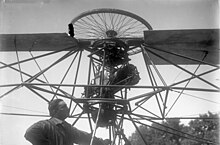Rotor head

The rotor head of a helicopter is used for the movable bearing of the rotor blades and transfers it to the torque of the drive.
construction
Its components usually include the swash plate , the flapping joints , the swivel joints , any swivel dampers and the blade connection fittings. These are often shaped so that the blades can be folded back by pulling a bolt at a time.
The rotor blades are mounted on the rotor head in such a way that they can be rotated around their longitudinal axis within certain limits, thereby changing their setting angle . The change in angle results when the swashplate is shifted in height (collective blade adjustment) or briefly inclined (cyclical blade adjustment) through control inputs from the pilot. The movement of the swash plate is transmitted to the blades via its push rods and the control levers attached to the blade feet.

Flapping joints and swivel joints are used to balance the aerodynamic and inertial forces, the latter often being equipped with additional dampers. In newer designs with a “rigid” rotor head, blades made of composite materials and elastic suspensions are used, for the first time on the Bo 105 , later further developed on the EC 135 or the Mil Mi-28 . This reduced maintenance and increased maneuverability.
Together with the drive, the rotor head forms the most complex and sensitive assembly of a helicopter. Regular pre-flight checks , inspections and careful maintenance of the rotor head are necessary in order to detect wear or emerging damage at an early stage and to remedy them. The high cost of this contributes significantly to the significantly higher operating costs of a helicopter compared to fixed-wing aircraft .
